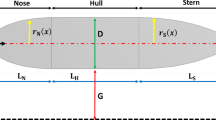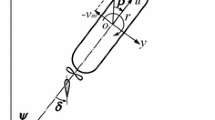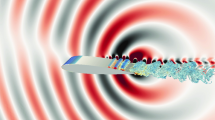Abstract
An approach for enhancing the realism of yacht fleet race simulations based on a lifting line method is developed. The wake of an upwind sailing yacht is represented as a single heeled horseshoe vortex and image system. At each time step, changes in vortex strength are convected into the wake as a pair of vortex line elements. These subsequently move in accordance with the local wind, the self-induced velocity and the velocity induced by the presence of the wakes of other yachts. In addition, the lifting line model has a model for the viscous wake due to the drag associated with the yacht and its sails superimposed on it. A synthesis of sail yacht wake representations based on detailed 3D Reynolds-averaged Navier–Stokes computational fluid dynamics calculations with wind tunnel test results is used to capture the initial strength of the combined main-jib vortex system and its vertical height. The implementation of the lifting line algorithm within Robo-Race, a real-time yacht race strategy analysis tool, is described. Two upwind race interaction case studies are presented, and these show that the newly implemented wake model makes an important contribution to enhancing the realism of the sailing simulation.


















Similar content being viewed by others
Abbreviations
- ACC:
-
America’s Cup class
- AI:
-
Artificial intelligence
- AoA:
-
Angle of attack
- AWA:
-
Apparent wind angle
- CFD:
-
Computational fluid dynamics
- C L, C D :
-
Lift and drag coefficient
- D :
-
Displacement vector
- L :
-
Sail rig and yacht length
- LLM:
-
Lifting line method
- NB, NBI:
-
Real and image bottom nodes
- NT, NTI:
-
Real and image top nodes
- NWM:
-
New wake model
- PM:
-
Philpott’s model
- q :
-
Variance of the random wind components
- Q :
-
Induced velocity vector
- r :
-
Radial distance
- RANS:
-
Reynolds-averaged Navier–Stokes
- S :
-
Sail area
- SST:
-
Shear stress transport
- TWA:
-
True wind angle
- TWS:
-
True wind speed
- u, v, w :
-
Induced velocities in the x-, y-, z-directions
- U AW :
-
Apparent wind velocity
- U o :
-
Freestream velocity
- U θ :
-
Tangential velocity
- U viscous :
-
Viscous velocity
- YL:
-
Yacht lengths
- Γ i :
-
Vortex strength of element i
- λ :
-
Distance along vortex element
- ρ air :
-
Density of air
- σ i :
-
Vortex core size
- Θ:
-
Momentum thickness
- θ :
-
Interval boundary angle
- ω :
-
Vorticity
References
Scarponi M (2008) Including human performance in the dynamic model of a sailing yacht: a combined ship science—behavioural science approach towards a winning yacht-sailor combination (Ph.D. thesis). Università di Perugia, Perugia
Scarponi M, Shenoi RA, Turnock SR, Conti P (2007) A combined ship science behavioural science approach to create a winning yacht–sailor combination. In: 18th Chesapeake Sailing Yacht Symp, Annapolis, MD, USA, 2–3 March 2007, pp 1–10
Parolini N, Quarteroni A (2005) Mathematical models and numerical simulations for the America’s Cup. Comput. Methods Appl Mech Eng 194:1001–1026
Philpott A, Henderson SG, Teirney DP (2004) A simulation model for predicting yacht match-race outcomes. Oper Res 52(1):1–16
Roncin K, Kobus JM (2004) Dynamic simulation of two sailing boats in match racing. Sports Eng 7(3):139–152 (Springer London)
Caponnetto M (1997) The aerodynamic interference between two boats sailing close-hauled. Int Shipbuild Progr 44(439):241–256
Nivelleau V, Nivelleau F (1994) Sillage aérodynamique du voilier—Cartographie générale du sillage—Etude locale (girouette)—interaction de deux voiliers. St-Cyr-l’Ecole, Paris
Caponnetto M, Castelli A, Bonjour B, Mathey PL, Sanchi M, Sawley ML (1999) Sailing yacht design using advanced numerical flow techniques. In: 14th Chesapeake Sailing Yacht Symp, Annapolis, MD, USA, 29–30 Jan 1999, pp 97–104
Euerle SE, Greeley DS (1993) Toward a rational upwind sailing force model for VPPs. In: 11th Chesapeake Sailing Yacht Symp, Annapolis, MD, USA, Jan 1993, pp 75–86
Sugitomo T (1999) A method for optimising sail design. Sports Eng 2:35–48
Katz J, Plotkin A (2001) Low-speed aerodynamics, 2nd edn. Cambridge University Press, Cambridge
Morozov VV, Kalyadina TV (2008) Green’s model of cylindrical vortex decay. Comput Math Model 19(2):186–194
Jackson W (ed) (2001) Wake vortex prediction—an overview. Transportation Development Centre/Transport Canada, Ottawa
Tennekes H, Lumley JL (1972) A first course in turbulence. MIT Press, Cambridge
Spenkuch T, Turnock SR, Wright AM, Shenoi RA (2008) The use of CFD in modelling blanketing effects for yacht race simulations. In: Numerical Towing Tank Symp, Brest, France, 7–9 Sept 2008
Spenkuch T, Turnock SR, Scarponi M, Shenoi RA (2008) Lifting line method for modelling covering and blanketing effects in yacht fleet race simulation. In: 3rd High Performance Yacht Design Conf, Auckland, New Zealand, 2–4 Dec 2008
Author information
Authors and Affiliations
Corresponding author
About this article
Cite this article
Spenkuch, T., Turnock, S.R., Scarponi, M. et al. Modelling multiple yacht sailing interactions between upwind sailing yachts. J Mar Sci Technol 16, 115–128 (2011). https://doi.org/10.1007/s00773-010-0115-9
Received:
Accepted:
Published:
Issue Date:
DOI: https://doi.org/10.1007/s00773-010-0115-9




